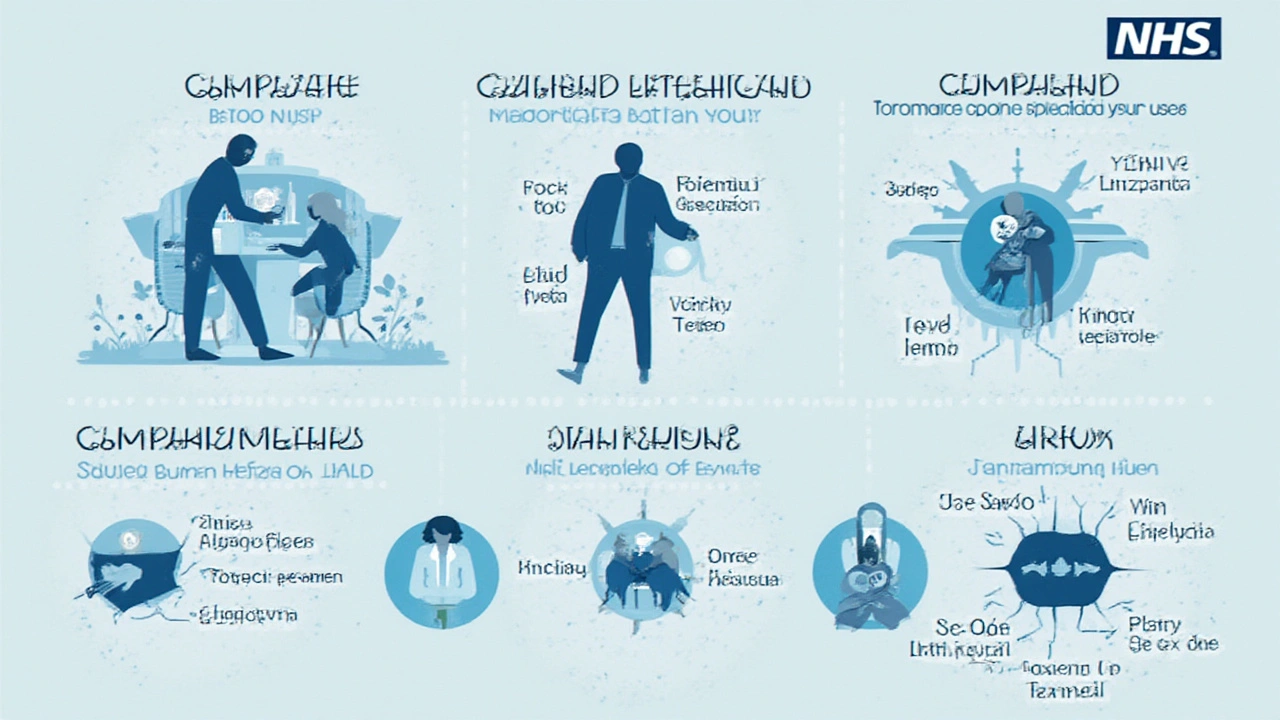Imagine you’re in the middle of a movie you’ve waited weeks to see, but you’re barely able to pay attention. Your stomach is flipping, you feel dizzy, and every sound around you becomes just noise. For people who get hit hard with nausea—whether it’s from migraines, cancer treatment, or just the stomach bug—this is a too-common scene. Compazine, a medication that’s been around since the 1950s, often steps in to save the day. But its backstory, uses, and side effects are honestly way more interesting than most folks realize.
What Is Compazine, and What Makes It Stand Out?
Compazine isn’t just another anti-nausea pill. The generic name is prochlorperazine, and it was first approved in the U.S. in 1956. When people hear the word “antipsychotic,” their first thought probably isn’t something they’d take for a queasy stomach. But that’s what’s unique—Compazine belongs to the class of drugs known as phenothiazines. These were some of the earliest antipsychotic medications used primarily for schizophrenia and other mental health conditions.
You can find it prescribed both in tablet form and as a suppository. Hospitals often use the injectable version for emergencies, especially if someone can’t take medicine by mouth. Compazine’s superpower? Blocking dopamine in your brain. This chemical is involved in everything from mood to how we feel physical sensations. Cut off those signals, and suddenly nausea, vomiting, and even some types of severe headaches start to back off.
But it’s not a one-size-fits-all solution. There’s a reason doctors don’t just hand it out like Tic Tacs for nausea. You see, while it’s FDA-approved to treat severe nausea and vomiting, doctors will sometimes use it "off-label"—meaning, for reasons not officially approved—like stopping migraines or calming anxiety if other meds fail. Here’s a weird thing: even though it’s an antipsychotic, modern psychiatrists hardly use Compazine for schizophrenia anymore. Today, it’s primarily known as the go-to for hard-to-treat nausea.
Compazine stands out for its fast action. Once it hits your system, it can start working in under an hour. The blood levels rise quickly, so many people feel relief from nausea in as little as 30 minutes if taken by mouth. The injectable—or IV—version kicks in even faster, which is why it’s often used in emergency rooms for those dramatic, can’t-stop-vomiting cases. Plus, it’s not outrageously expensive, making it accessible compared to newer drugs. Doctors sometimes select it when cost is a big concern.
Odd fact: According to the National Cancer Institute, among 100 cancer patients, up to 70 will get prescribed some anti-nausea medication. Compazine is still a top contender in this field, especially in older adults and those with chemotherapy-induced nausea. At the same time, the drug’s sedative effect—making folks a bit sleepy—can be either a blessing or a curse depending on the situation.
How Compazine Is Used in Real Life—Dosage, Administration, and Tips
The beauty and the challenge with Compazine is how flexible yet tricky its dosing can be. Doctors tailor the dosage based on what’s being treated, how severe the symptoms are, and the person’s age. For adults battling nausea, the regular dose is usually 5 to 10 mg, every 6 to 8 hours, but some need less and some more. Kids get a reduced dose, and older adults usually need it even lower to avoid side effects. In hospitals, the injectable form is often given as a one-time dose to jumpstart relief.
Compazine tablets are best taken with a sip of water and food if they upset the stomach. The suppository form? It’s not everyone’s first pick, but sometimes it’s the only way if vomiting is relentless. Here’s a pro tip—don’t cut the suppository; it’s meant to be whole to work correctly and safely.
If you’re using Compazine long-term (which is rare for nausea—much more common for psychotic disorders in decades past), doctors keep a sharp eye out for certain problems. They might check your muscle function, run blood tests, or ask about stiff movements and restlessness. Here’s an interesting routine: some oncologists recommend pairing Compazine with other anti-nausea drugs. That combo approach can work better for tough cases, especially during cancer treatment.
One thing I noticed from patients: food can cut down on stomach irritation. So, if you feel queasy after taking Compazine, try having a slice of toast or crackers. Keeping hydrated helps, too. If you miss a dose, take it as soon as you remember—unless it’s almost time for your next one. In that case, skip it (don’t double up). This stuff isn’t addictive, but you also shouldn’t just stop it cold turkey—talk with your provider about adjusting the schedule if you think you’re done.
Some folks love that sleepy feeling Compazine causes; they use it at bedtime to help both with nausea and insomnia. But others hate it, especially if drowsiness interferes with work or daily tasks. You might want to avoid driving or heavy machinery until you see how your body handles it. Oh, and don’t combine it with alcohol—it’s like turbocharging the drowsiness.
| Form | Typical Adult Dose | When Used |
|---|---|---|
| Tablet (oral) | 5-10 mg every 6-8 hours | Mild to moderate nausea/vomiting |
| Suppository | 25 mg twice daily | Severe, persistent nausea/vomiting |
| Injection (IV/IM) | 5-10 mg every 3-4 hours as needed | Emergency use, severe cases |

Side Effects—What’s Worth Worrying About?
It’s easy to get lost in the weeds of medication risks, but Compazine’s side effects are worth knowing. The drowsiness is the most common—think old-school antihistamine sleepy, not just a little yawn. Dry mouth, blurred vision, and constipation tag along for some. A more serious group of side effects, called “extrapyramidal symptoms,” can cause twitchy muscles, restlessness, or feelings of being unable to sit still. About 1 in 20 people will experience some of these symptoms from Compazine, which is higher than a lot of newer drugs.
There’s a rarer but more serious risk called tardive dyskinesia. This is where people develop involuntary movements—grimacing, chewing, smacking lips. It usually only happens with high doses or long-term use, but it’s a red flag worth remembering. Young kids and people over 65 have a slightly higher chance of these muscle side effects. If you feel like you can’t stop blinking, fidgeting, or your jaw gets stuck, call your doctor—don’t just ride it out.
Another potential issue: drops in blood pressure, especially when getting up from bed or a chair. You stand up too fast, and your world spins for a second. It’s most common in older adults and can lead to falls. Staying hydrated and moving slowly from lying to sitting or standing helps a lot. Some folks also report headache, skin sensitivity to sunlight (so sunscreen and hats are smart if you’re out for long), and sometimes even mild mood changes or a "cloudy head."
If you notice high fever, stiff muscles, fast heart rate, or confusion, call for help. These could be signs of a rare but dangerous condition called neuroleptic malignant syndrome. Most people will never run into this, but it’s worth knowing what to watch for. Same for allergic reactions—trouble breathing, swelling of lips or face, or hives need immediate medical attention. As with pretty much any drug, if you’re pregnant or breastfeeding, it’s best to talk with your provider about risks, especially in the first trimester of pregnancy.
Doctors often check for drug interactions. Compazine can increase sedation when mixed with antihistamines, sleeping pills, anxiety meds, or alcohol. There’s some evidence it can mess with blood pressure meds and even a few antibiotics. Carry a med list (snap a pic on your phone) to share at appointments, so nobody misses a dangerous mix.
| Side Effect | Frequency |
|---|---|
| Drowsiness | Common (>10%) |
| Restlessness (Akathisia) | About 5-10% |
| Twitchy muscles (Parkinsonism) | Up to 5% |
| Tardive Dyskinesia | <1%, usually after long-term use |
| Sunlight sensitivity | About 2% |
Some folks want to know about withdrawal or dependence. The truth? Compazine isn’t habit-forming, but suddenly stopping after long-term use can make nausea or headaches return with a vengeance. Tapering down is best, with guidance from a healthcare provider.
Key Takeaways and Real-World Wisdom
Is Compazine still the right option in 2025? For many, it’s a lifeline—especially folks going through chemo, stuck in bed with migraines, or battling severe stomach bugs. The trick is knowing when to reach for it and when something else makes more sense. Newer meds like ondansetron (Zofran) tend to have fewer side effects, but they don’t always work as well for severe or stubborn nausea. And let’s be honest—affordability matters for most of us. Compazine is generic now, so it’s way cheaper than many alternatives.
I’ve met people who swear it’s the only thing that lets them keep fluids down when nothing else works. Others tried it once and vowed never again because of the zombie-like tiredness or that weird jittery feeling. It’s a classic example of “your mileage may vary.” If you’re new to the medication, start low and go slow—take the smallest dose that gets the job done and see how your body reacts during a quiet day at home.
One tip: keep anti-nausea options handy if you or a family member is prone to stomach bugs, travel sickness, or get migraines that make you throw up. Having Compazine prescribed—just in case—gives peace of mind, especially for those who get sick often. Just make sure it stays within the expiration date, as medicine effectiveness drops off after that (check the bottle).
Something a lot of people miss: diet and hydration make a difference. Sipping clear fluids or sucking on ice chips can help between doses. Resting in a quiet, dimly lit room is a trick that migraine sufferers swear by—and it pairs well with the drowsy effect of Compazine. And if you don’t like how you feel on it, don’t tough it out—ask your doctor about alternatives. There’s a whole toolbox out there now, and for every person, the best fit can be different.
Trust is big here—always be straight with your provider about symptoms and side effects. This isn’t the kind of drug you want to “self-prescribe” based on what works for your friend or parent. As common as Compazine is, the people who do the best are the ones who ask questions, pay attention to their bodies, and have a plan for what comes next. And if it ends up being the thing that gets you through a rough patch, you’ll probably become a real fan. But if not, don’t worry—there are more solutions than ever before, and that’s something to be grateful for.

